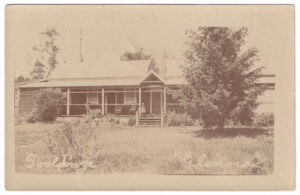[Editor: This postcard, which incorporates a photo of a house at Toolangi (Vic.), is undated; however, it is believed to have been published in the early 20th Century.]
[Front of postcard]
[Description: A photo of a house, with “Toolangi” (the name of the locality) in the bottom-left of the postcard, along with “Glenora” (the name of the property) in the bottom-right.]
[Reverse of postcard]
[Handwritten text, in italics]
To Ellen
with love & best wishes
from all at “Glenora”
Source:
Original document
Editor’s notes:
Dimensions (approximate): 138 mm. (width), 89 mm. (height).
This postcard was produced on cardboard manufactured by Kodak Australia.


Dear Ed. Okay, this will challenge me to explain what I mean.
In your “Description” above; you give that “Toolangi” is given in the bottom left. Which it is. But with no inverted commas — and I understand that you inserted them for clarity etc.
However, you seem, understandably to not have seen that, faintly, on the bottom right-hand side, there is another name, which is given within inverted commas as “Glenora”.
And the hand-written inscription which you give, is from ‘all at “Glenora” ‘.
Therefore, my interpretation is that this is a postcard of a residence or property known as “Glenora”, situated in a place called Toolangi; whence it was sent to “Ellen”.
Several internet search results provided references to a town or place called Toolangi, very close to Kinglake and Healesville in Victoria — which may very well mean that the residence in this photo might have been lost at some stage in a bushfire.
A Wikipedia entry gives as a source, a publication, as follows:
“… THE TOWNSHIP OF TOOLANGI – PAST AND PRESENT collated by Ian Whitford … “; but I can so far find no reference to this publication in the National Library of Australia site: nla.gov.au
Hi Raymond,
Thank you for picking up on that name in the lower-right. The description of the postcard has now been changed.
When I look at the photo on the IAC site, it now seems so obvious.
But when I look at the original, with the light shining from above onto the glossy photo, I can see how the glare obscures the writing (excuses, excuses).
It just goes to show that one should look carefully at both the original and the scanned image before writing about an item.
I had originally hoped that this might have been a photo of the house owned by C. J. Dennis at Toolangi, but a look at a photo of his home shows that it was two stories high at the left-hand end (when looking towards the front door).
Nonetheless, this postcard still provides us with a nice historical photo.
Thank you once again for your helpful input.
Ed.
Dear Ed.
I am doing a lot of smiling at the humour in your recent responses, just like in this one too. Thanks for the smiles as well as all that you do.
C.J. Dennis: YES, when my internet searches threw up that he had lived at Toolangi, I realised how that connection would mesh with all that IAC is about. Such a pity that your own researches have now shown him to have lived in a different building.